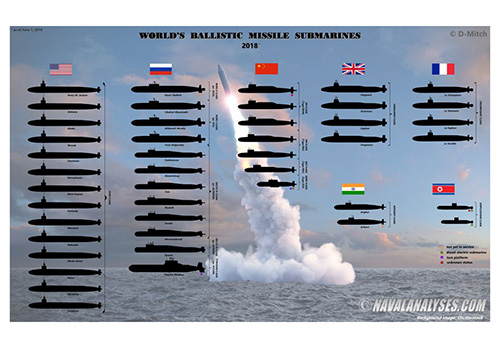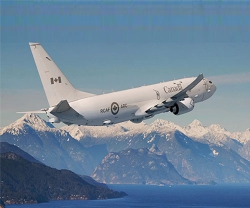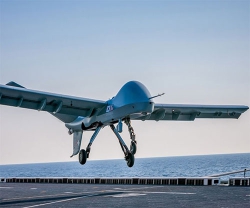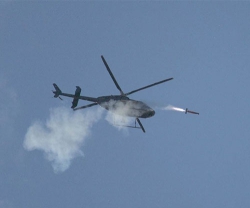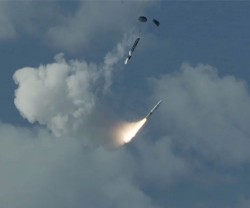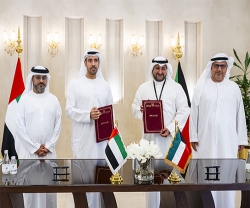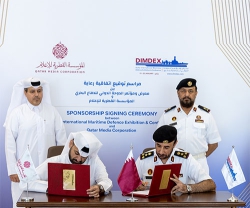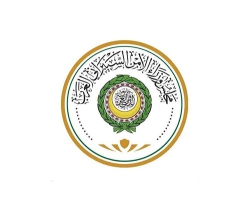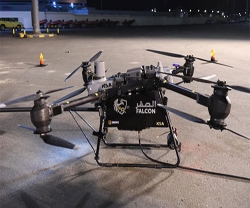The ballistic missile submarine is the most reliable means of nuclear deterrence. These vessels would survive a first strike and retaliate, which is meant to prevent an enemy from ever using its weapons. These fearful underwater giants stay hidden in the oceans avoiding detection at all costs and are always ready for the moment they might be needed.
Until the early 1980s, only four countries in the world had nuclear-powered ballistic missile submarines (SSBNs) in their inventory: the two superpowers, the Soviet Union and the United States, plus the United Kingdom and France.
In 1987, China became the fifth country after commissioning a Xia class submarine, the first SSBN designed and built in Asia. Just a few years ago, two more countries joined the club - India with the first submarine of its Arihant class and North Korea with its Sinpo (otherwise known as Gorae) class of diesel-electric ballistic missile submarine.
The United States Navy currently operates the biggest fleet of ballistic missile subs, consisting of 14 18,800-ton Ohio class nuclear-powered ballistic missile submarines (SSBNs). France and the United Kingdom operate four SSBNs each, with France's belonging to the 14,300-ton Triomphant class and the United Kingdom's the 15,900-ton Vanguard class. All American, French, and British boats are nuclear-powered and are the largest submarines ever built by each country.
The American Ohio class and British Vanguard class boats both carry Trident II missiles, with 24 SLBMs on each Ohio and 16 SLBMs on each Vanguard. Each Trident II carries eight to 12 Multiple Independently Targetable Reentry Vehicles (MIRVs) with ranges up to 7,500 miles. The French Triomphant boats carry 16 M51 missiles; each M51 carries ten MIRVs and has a range of up to 6,200 miles.
The Russian Navy deploys a ballistic missile submarine fleet consisting of four 24,000-ton Borei I class SSBNs (the fourth vessel and lead ship of the Borei II class, Knyaz Vladimir, is scheduled to enter service this year), six 18,200-ton Delta IV class SSBNs, one recently overhauled Delta III class SSBN (Ryazan), and the last of the largest submarine class ever built, the giant Typhoon class Dmitriy Donskoy (TK-208). Donskoy operates as a test missile platform for the new Bulava SLBM. With an estimated submerged displacement of more than 48,000 tons, Typhoon class boats have more than twice the total displacement of the American Ohios, yet carry four fewer missiles.
Borei I/II SSBNs carry 16 Bulava SLBMs, the most expensive weapon project in Russia, each with a range of approximately 6,200 miles and armed with six to ten MIRVs. The seven Delta III/IV SSBNs carry 16 of the older Sineva SLBMs, which each carry four to eight MIRV in a range of up to 5,100 miles with a full payload. It is reported that the Sineva missiles have been upgraded to the new Layner standard, a highly advanced derivative of the Sineva, which carries up to 12 MIRVs (warheads can be of a mixed set with various yields).
The Chinese ballistic missile submarine (SSBN) fleet consists of at least four (and possibly as many as six) Jin class (Type 094/094A) SSBNs, as well as the sole Xia class (Type 092) SSBN. Some sources report also a sub-variant, the Type 092G, consisting of a pair of boats.
China operates also a sole boat of the Type 032 “Qing” class, a diesel-electric submarine currently as a missile-firing testbed for the People’s Liberation Army Navy. The Type 032 is said to be the world’s largest conventional submarine, with a submerged displacement of 6,628 tons and a length of 305 feet. This impressive vessel is armed with a number of 533 to 650-millimeter torpedo tubes, two to three missile silos in the sail and four vertical launch tubes VLS for cruise missiles, anti-ship missiles, and anti-submarine missiles in the forward section. The submarine also tests new technologies including new torpedoes and missiles, unmanned undersea vehicles, and others.
India and North Korea are newcomers to the very exclusive ballistic missile submarine club. The 8,000-ton Arihant joined the Indian Navy in 2016. It is the first Indian ballistic missile submarine (also the first SSBN designed and built by India), and the first such submarine to have been built by a country other than one of the five permanent members of the U.N. Security Council. The Arihants carry up to 12 K-15 missiles in four launchers, each armed with one warhead with a range of 466 miles or four K-4 missiles with a range of 2,174 miles. A second, slightly larger vessel will join the fleet this year with eight missile launchers to carry up to eight K4s or twenty four K-15s.
The 1,700-ton Sinpo class (also called the Gorae) SSB is the largest submarine designed and built for the Korean People’s Navy. The Sinpo is the smallest ballistic missile submarine today and, aside from China’s Type 032 test boat, the only one that is diesel-powered. Only one submarine has been observed in service. The boat features one launch silo in the conning tower. The KN-11 ballistic missiles are estimated to have a range between 745 and 1,550 miles.
A new submarine, designated Sinpo-C by the U.S. government was recently detected by U.S. intelligence. This boat is larger than the first vessel in the class and probably exceeds the 2,000 tonnes submerged displacement while it carries possibly more than one SLBM. Its status is unknown.

